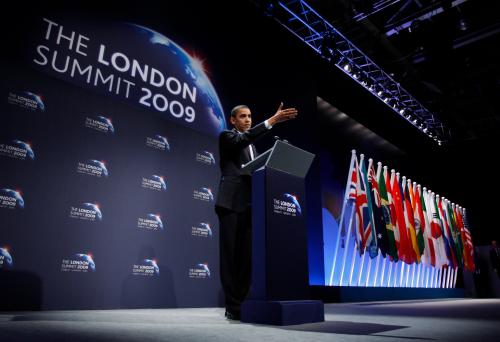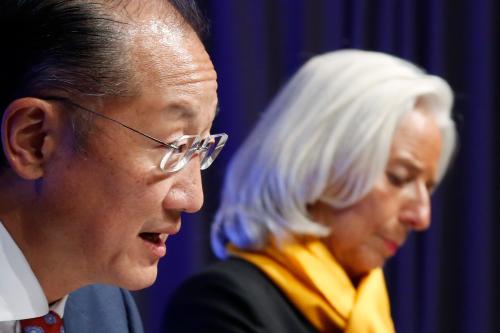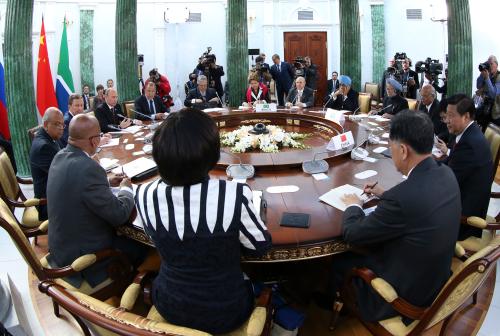This week, Latin American policymakers are descending on Washington, D.C. for the World Bank and IMF Spring Meetings. As they gather together with their counterparts to discuss the global economy, it would be fair to say that emerging economies are breathing a sigh of relief. The odds of tail-risk scenarios—such as the breakup of the eurozone or the Fed removing monetary stimulus and raising interest rates too soon and too fast—appear to have been greatly reduced. Such scenarios, which the markets now estimate as unlikely to materialize, would have resulted in a highly disruptive interruption in capital inflows, sharp declines in commodity prices and severe macroeconomic adjustment.
Suffice it to say that the mere announcement of the Fed tapering in May 2013 led to a full 1 percentage point increase in U.S. Treasury bond yields, a rise in EMBI yields in excess of 2 percentage points, and severe declines in asset prices and currencies. Moreover, countries that were the main beneficiaries of nearly a decade of very large capital inflows—leading to above average historical growth, a steep rise in asset prices, large currency appreciation and current account deficits—were hit the hardest.
The reduced probability of extreme events that could traumatize international financial markets comes at a time when markets expect the recovery of advanced economies to gain momentum in 2014.
Moreover, most countries in the region are in a stronger financial position to withstand financial turbulence due to higher levels of international liquidity relative to short-term liabilities and lower balance sheet vulnerability to currency depreciation than in the late 1990s. The combination of an improved financial position and a relatively benign external environment has shifted the market’s sight from financial risks to productivity issues. With Latin America´s expected growth of a lackluster 3 percent in 2014, productivity-enhancing reforms become a priority. In fact, low growth rates are the main reason behind the more negative perception that rating agencies have taken towards most of the region.
This shift in focus towards pro-growth reforms is welcome after a decade of complacency in which many countries in the region displayed above average performance riding on favorable —and now waning— external tailwinds. However, the shift in focus away from macro-risks is premature to say the least.
Back to Fundamentals?
With financial risks apparently in retreat, policymakers need to turn their sights to a different kind of macro-risk: gradually deteriorating fundamentals.
Even if expected —and even worse if unexpected— a relatively small rise in long-term U.S. interest rates can have a disproportionately large macroeconomic impact, resulting in a potentially significant slowdown in investment and durable consumption.
First, it is precisely the expectation of future increases in interest rates that keeps the demand for investment and consumption of durable goods high, as consumers and firms bring forward spending in these items to lock-in low rates. As rates increase and domestic demand contracts, slower growth, currency depreciation, declining revenues (which in Latin America are very sensitive to domestic spending), and higher fiscal deficits are the inevitable outcomes.
This is especially true for those economies where domestic demand growth fueled by large capital inflows has so far remained strong in spite of growth deceleration since mid-2011. These are precisely the economies that display current account deficits and where the dollar value of assets and unit labor costs is still very high. In fact, it is these economies that were hit the hardest in the aftermath of last year’s surprise Fed tapering announcement.
Second, the levels of total indebtedness in the region (public and private, external and domestic) are currently as high as they were in the late 1990s (close to 100 percent of GDP) as a result of very high domestic financial institutions’ credit growth and abundant foreign financing. As U.S. interest rates rise, financial deleveraging will be an extra drag on the economy, depressing further consumption and investment, growth and fiscal revenues.
Higher borrowing costs, lower growth and weaker revenues in light of relatively inflexible expenditures (a recent Inter-American Development Bank report documents that, on average, more than two-thirds of the increase in spending since the Great Recession stems from items that could be labeled inflexible), will lead to higher fiscal deficits and potentially unsustainable public debt dynamics.
After close to a decade of high growth, booming revenues and public spending, and high expectations about the active role of the state, a dissatisfied electorate will be putting pressure on governments to avoid necessary adjustments in public spending, making governments prone to accommodate popular demands at the expense of sound and sustainable policies.
First, in order to avoid cuts in politically sensitive programs, governments may choose to adjust public finances by introducing distortionary taxation and/or sub-optimally reducing investment, thus hampering future growth. Alternatively, countries with access to credit markets may allow public debt to rise, delaying politically costly reductions in public spending.
In countries such as Argentina with no access to international capital markets, these tensions are already obvious. The deterioration in its fiscal position since 2011, financed by money creation and thus higher inflation and the loss of international reserves, has raised the specter of a currency crisis.
Conclusion
While remaining vigilant about apparently fading financial risks, policymakers should turn their attention not only to productivity-enhancing pro-growth reforms but also to another kind of macro-risk: gradually deteriorating fundamentals. In contrast to financial risks that disrupt access to international liquidity, deteriorating fundamentals are a more subtle, less dramatic and more elusive strain of macro-risk, since they do not usually require immediate attention if access to credit is available.
Ironically, after experiencing a succession of 21st century liquidity crises in the region since the tequila crisis in 1994 and having made substantial progress in reducing financial vulnerabilities, there is a chance that some of the long-forgotten fundamental problems that haunted the region just a few decades ago might gradually come to the forefront. For most countries in the region, this is not a clear and present danger, but policymakers should take due notice.



Commentary
The Upcoming World Bank and IMF Spring Meetings: What Should Latin America’s Policymakers Be Concerned About?
April 9, 2014